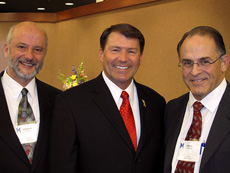Deep down

Fermilab Director Pier Oddone, South Dakota Governor Mike Rounds and
Brookhaven National Laboratory Director Sam Aronson visited Homestake Mine in South Dakota last week.
Last Thursday, groups from DOE, NSF, Fermilab, Brookhaven National Laboratory and Lawrence Berkeley National Laboratory visited the Homestake mine, the site selected by NSF for the proposed Deep Underground Science and Engineering Laboratory (DUSEL). Currently Homestake is the site of the Sanford Underground Laboratory, funded jointly by the State of South Dakota and a private donation by Denny Sanford, a prominent citizen of South Dakota.
Homestake is a legendary site for particle physics, the location of the "Davis" cavern where Ray Davis carried out his ground-breaking experiment starting in the 1960s to detect neutrinos from the Sun. His results were the first indication that neutrinos were not behaving as expected. This behavior was finally elucidated by the Super Kamiokande experiment in Japan, which Masatoshi Koshiba worked on. Davis and Koshiba shared the Physics Nobel Prize in 2002 for the detection of cosmic neutrinos. (The physics prize that year was also shared by Riccardo Giacconi for the discovery of x-ray sources).
During our visit we were able to go down to the level at 4,550 feet below the surface, near the 4,850 foot level where we envision the major development of large caverns for neutrino and proton decay experiments. The 4850 foot level is not yet reachable because the mine was flooded in the gap in operations during the mine transfer from the private sector to the State of South Dakota. On an easy day to remember, my birthday, March 26, 2009, the water level was at 4,830 feet, very close to allowing the development of the 4,850 foot level. Eventually the mine will be de-watered all the way down to the 8,000 foot level.
The existing infrastructure for carrying people to that level and hauling out debris from excavations is impressive. Huge lifts developed in the 1930s and beautifully maintained can lift 11 tons of materials per lift and make well over 150 lifts a day. The mine is well characterized since there are 400 miles of underground tunnels developed when Homestake was the largest gold mine in the western hemisphere. The ventilation system makes life at nearly 5,000 feet deep quite comfortable.
The commitment of the State of South Dakota is impressive. The governor, the Honorable Mike Rounds, spoke eloquently to us about South Dakota's commitment to education. He described the important role that this deep underground laboratory already plays in the education of future generations by inspiring young South Dakotans and many others to explore the profound mysteries of nature and undertake scientific careers.
A long base-line experiment to a distant site like Homestake would anchor the long range neutrino program at Fermilab. We envision three phases in this program. The first phase is the current phase with the MINOS, MiniBooNE and SciBooNE experiments. The intermediate phase will develop the NOvA, MicroBooNE and MINERVA experiments. The final phase to come into operations late in the next decade would be a world-leading program involving the long baseline experiment from Fermilab to Homestake. We are fortunate to have the promise of great results all along this trajectory.
|